‘In The House’, with David Neice
Review Article: DALI Oberon 5 Speakers
MSRP: $1399 (Canadian)
Verdict: Taking up much less floor space than a stand mount speaker (when on a stand), the diminutive DALI Oberon 5 floor-standing speakers deliver on so many sonic fronts that it is hard to know where to begin. Always terrific fun to listen to and highly balanced, these condo-friendly floorstanders break the mold for what can be achieved on a budget. DALI is to be commended for bringing their sharp as a razor sound field to audiophiles of more modest means.

The DALIs are decor-friendly and WAF favourable and will fill the bill in any downsizing exercise that an audiophile might be engaged in, such as a move to a condo or a smaller residence. For someone new to the hobby or looking to shift from headphones to speakers, they offer an ideal upgrade path.
Others may think of them for a second system or for TV use, but believe me when I say their performance far exceeds most ‘second system’ level speakers. I have them firmly embedded in my main system and they are not going anywhere. I will be using them in future to evaluate other floorstanding speakers as I continue to review gear for Wall of Sound.
The DALI Oberon 5 speakers are highly recommended and are hereby awarded a Wall of Sound Gold Star for value and sound quality.
Caveat Lector (Reader Advisory)
I have a problem with floorstanders. I have tried many times to warm up to them and have been through many models over the years, and they just don’t last. I always seem to return to stand mount speakers, mostly two-way designs and occasionally three-way systems.
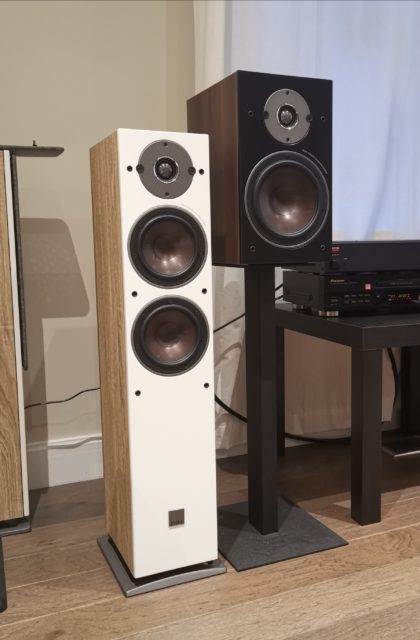
Why is this? I am not really very sure. There’s something about the sound field of a well designed two-way stand mount speaker that just ‘speaks to me’. I think part of the answer may be found in the imaging. If the cabinet and enclosure of a stand mount is kept reasonably small (the ideal being a point source), there is a good chance that with clever engineering they will image like champions. Lovers of mini-monitors, and I am certainly one of them, often find that floor-standers introduce cabinet diffraction effects that compromise the ultimate precision of the image.
In addition, floorstanders are frequently burdened with ‘extra drivers’, and in some cases (maybe for marketing purposes) they sport multiple mid-bass drivers or else extra passive radiator cones that are employed to fill out the bass, often to the neglect of other aspects of the sound field. The intention is to impress the beginner, both visually and with enhanced bass effects. But these are things that the buyer will then quickly tire of when they are brought into the home. Such are the vagaries of hi-fi sales.
The subject of this review, the DALI Oberon 5 foorstanders, neatly sidestep the above two issues. First, the cabinets are exceptionallly small and tightly defined, so cabinet diffraction effects are less likely and imaging will likely be improved. Secondly they use a two mid-woofer driver design where the top small mid-bass unit is reinforced with another identically-sized unit placed just below it and then a wide dispersion tweeter is placed above the two of them.
So visually the speaker looks (and also behaves) like a simple two-way design. Unlike my samples of floorstanders from the past, this is a floorstander that I can live with, and I will for some time. More about this later.
The Stereo Effect
It is incredible when you really think about it. The entire audio industry is based on the maintenance of an audible illusion! That illusion is ‘the stereo effect’, in which the reproduction and positioning of instruments and vocals within a sound field is the main design goal.
I contend that lots of people have heard sound coming from two speakers, but only some have really heard the stereo effect. Many of you will know what I mean. You visit friends and their speakers are scattered around at odd angles and in odd places and topped with ashtrays or cup holders. There is no attention paid to equidistant spacing and on axis sound, and usually decor issues reign supreme.
Despite their modest cost, the DALI Oberon 5’s are stereo effect and imaging champs. The stereo effect is such a pronounced, central characteristic of these speakers that even a dolt could hear it. This is a hallmark feature of all the DALI lines of speakers. By using wide dispersion drivers, the company is attempting to make it possible for more owners to truly realize the stereo effect. They may not revolutionize home listening, but they are trying. As well, with DALI speakers, the stereo effect covers a lot of territory and even when well off axis the image is strong and clean.
Who is DALI?
DALI stands for Danish Audiophile Loudspeaker Industries, a modern factory complex which was started in 1983 by Peter Lyngdorf, who previously owned NAD, and then founded the Danish Audio Club or “hi-fi klubben”. The purpose of that club was to foster better sound in the home, and eventually they began developing speakers to that end, The resulting company is the direction in which this local Danish audiophile movement grew.
DALI has grown considerably and earned a reputation as a company that invests heavily in R&D, machining and producing many parts in house, including the drivers. They produce several lines of speakers at various price points and these reflect different technologies and levels of cabinet finish. The Oberon line has five stereo models, two are stand mounts, two are floorstanders and there’s also a wall mount speaker. In addition there is a center channel model for home theater folks. The DALI Oberon line sits in the lower middle of their numerous speaker lines and despite the modest pricing, seems to benefit from trickle down technology first developed for their more expensive lines.
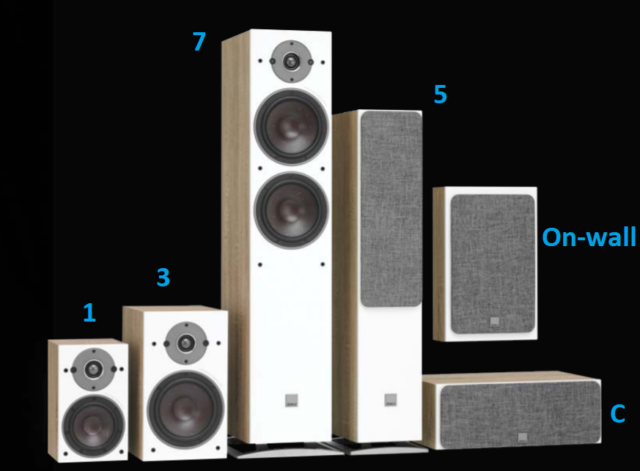
Description
These are small-footprint bass reflex speakers. They stand a mere 33 inches high and are only 6.5 inches wide and 10.5 inches deep (83 * 16.2 * 28.3 cm). When placed in the stereo position, they appear to be about half the size of most stand-mount speakers. However, tiny or not, they are quite stylish and my samples are finished in Light Oak (vinyl) with white front baffles and grey textured cloth speaker grills.
Some buyers may ask why the wood finish is not a real veneer, but there are limits on what can be done at this price point. Each speaker unit is raised slightly on an attached (sturdy plastic) bottom plinth that isolates the units from the floor and gives them stability. Spikes are included in the package, if you prefer them.
The DALIs sport two stacked mid-woofer drivers of about 5.25 inch (13 cm) sizing and a 29 mm soft dome high dispersion tweeter. The binding posts are not bi-wireable but are good quality five way posts. Overall, to look at them there is nothing very exceptional about their design; they just seem to be another small bass reflex enclosure with bog standard design elements. However, their overall execution places them on higher ground and it is clearly the synergies that the components bring to the table that accounts for their compelling performance.
Looking closer – besides the inclusion of the wide dispersion tweeters, are the materials used in the cones of the mid-woofers as well as special materials used in the mid-woofer magnets.
Regarding the cones, DALI says: “The Oberon woofer features a wood fibre cone with a blend of fine grain paper pulp, reinforced with wood fibres, which creates a stiff, light-weight and well-behaving structure.” I am quite partial to paper and wood fibre cones, and in this case the result is an agile mid-range with great harmonic response – thus rendering difficult instruments like piano as realistically as I have ever heard.
DALI also holds a proprietary patent on the Soft Magnetic Compound (SMC) that it deploys to various effect in its driver magnets. The pole piece of the Oberon series woofers has a SMC disk attached to the rear of it, thereby helping to minimize the electromagnetic effects of the iron. (video link) According to DALI: “The use of the SMC disk greatly reduces mechanical distortion, which lowers third order distortion. This allows for a longer listening pleasure, a relaxed midrange and a surprising amount of detail for its price class.” I wholly concur.
Listening Reactions
I was quite excited to hear these little darlings, as previous reviews and reports I had received were quite stellar. So when I received a pair, I didn’t wait very long to get them up and running. The first and lasting impression was of a big, full and robust sound field with gobs of PRAT. My legs and feet started tapping with the very first cuts I played. I noticed immediately their great midrange resolution and extended bass with real impact, and I began to think that the cabinets must be involved in boosting the sound field.
These are tiny speakers, hardly there visually, and yet they throw a large and very well fleshed out sound field. A totally inert cabinet this size should not produce this sort of size and scale. I came to wonder if the cabinet walls of MDF have a lossy effect that boosts the output of the lower mids. Spendor does something like that with their smaller A line floorstanders. These are, after all, pretty small speakers but they generate a surprisingly big and pleasing soundstage.
With more listening, their sense of BALANCE emerges. There is just no part of the frequency spectrum that gets extra attention. Top to bottom they are as smooth as a baby’s bottom, and as well articulated as a robotic arm. The midrange is spectacular and the clarity of vocals is surprising. With these babies you will not be reaching for lyric notes as often. If the recording is good, you will get it all. Once again I return to their balance but in another direction – they are both sweet and delicate but also robust. One would think these characteristics are mutually exclusive, but with the DALIs these qualities just seem to be natural partners.
The bass energy is well articulated, quite natural and seems to blend seamlessly with the middle harmonic ranges. By example, a friend brought over a CD by Russell de Carle (formerly of Prairie Oyster) called ‘Under the Big Big Sky’. The entire album is worthy of a listen, but track #2 ‘Baby Don’t Come Round Here Anymore’ really caught my ears. There is an extended solo on stand up bass on this track, and the DALIs were found to be astonishingly adept at both detailing the low frequencies and supporting the upper harmonics that a good stand up bass throws out. I played it several times and was delighted at the veracity conveyed.
DALI makes sure that owners are aware that their speakers do not require toe-in. This is highlighted on their web user guides. The speaker’s wide dispersion characteristics mean that on-axis listening is extended to some extent to the left and right. Ever the inveterate tinkerer, I still endeavored to see if a sweet spot could be optimized. I found it with just 3 degrees of toe in and 2 degrees of upward tilt.
With the speakers placed seven feet apart and the listening chair placed seven feet away on the equilateral lines, the image is highly focused. But the bonus is that this small amount of toe-in still allows other adjacent listeners to benefit from the on-axis stereo effect. Within the sweet spot I would put the resulting image as about sitting in row G or H, which is more forward than row M (centre of house), but which produces an immersive and absorbing sound field,
For sure, specific speakers cannot be all things to all people. These are ensemble speakers – this is the territory they own. For sure these are not big rock speakers. The only times I tripped them up was when I expected them to scale to rock concert levels. This will just not happen. So put away your copy of The Who ‘Live at Leeds’ and pull out your ensemble CDs and vinyl. (Dude, you use an 11-watt amp. -Ed.)
The types of ensembles, whether classical or folk or jazz or R &B is irrelevant, all will be well served. If a CD or vinyl album has music on it made by say between two to twelve musicians playing naturally and having fun, then you will be delighted. Ensemble sessions could be live or studio produced, it doesn’t really matter, because overall the DALIs will give you a faithful rendering of the underlying joy found in music.
Alison Brown is a banjo virtuoso and attracts other instrumental players who are exceptional at their craft. Although her repertoire has a footprint in Appalachia bluegrass, there is so much sophistication to her music that I think of her as the George Benson of the banjo. Her music is not a rehash of ‘Dueling Banjos’, but is rather a jazz-tinged force to be reckoned with.
She is a master of ensemble playing and I cannot help but recommend two of her CDs as superb. While playing both ‘Stolen Moments’ and ‘Fair Weather’, I was immediately struck by the ability of the DALI Oberon speakers to unpack the instrumental layering that dominates these tracks. The picking on the instruments (fiddle, banjo, mandolin, guitar, stand up bass and piano) is lightning fast, played at almost blinding speed on many tracks – and yet these speakers let each note shine through even when the ensemble is working at a ferocious pace. It is just a revelation to hear all these natural sounding folk instruments played at this blazing pace.
I was also struck by the ability of these speakers to unpack layers of electronic soundscapes, as produced by solo artists such as Moby or by the french duo Air. Moby’s track ‘Memory Gospel’ on the CD ‘Play-The B Sides’, is rendered in all its anthemic glory, with multiple layers of synth and organ and drums and grand piano. I never tire of hearing this track repeated multiple times. Similarly, the synthesized tracks on Air’s work ‘Pocket Symphony’ are rendered as sharp as a carving knife, and layers of compressed sound are teased out, so the listener can examine the full palette of electronic sounds and musical colours.
Tube or Solid State?
My usual preferred amplifier is a Unison ‘Simply Italy’, a low-wattage Class A EL34 tube design. As an experiment I substituted an Exposure 2010S V1. My reasoning was that many buyers would likely use a solid state integrated amplifier to drive these speakers – such as a NAD integrated, or a Rega Brio or the Heed Obelisk. The Exposure has a reputation for being light and airy, and the results were surprising.
First and foremost, with the Exposure the soundstage was if anything somewhat enlarged. It took on at least another foot of depth and width. I was quite surprised. Further, there was immediately more bass energy and slam, this being a predicted outcome when you compare it to a Class A tube amp.
The Exposure’s midrange might have a bit more bloom, and it might not be quite as lean as with the tube amp, but the exceptional clarity was still intact. The PRAT was retained and there was not a hint of vocal fatigue or the ‘shouting’ that so commonly afflicts less expensive samples of solid state amplification. There was albeit some loss of that organic quality that tubes seem to solely have a way of conveying. It could also be argued this is a euphonic colouration of tubes, even if it is a much sought after colouration.
The bottom line is that I can firmly recommend that these speakers can be paired with a capable, high quality integrated amp. The sonic outcome may not be identical to my Exposure, but I doubt it would be far different. I had previously boxed my Exposure up for sale, but I am now having second thoughts about that.
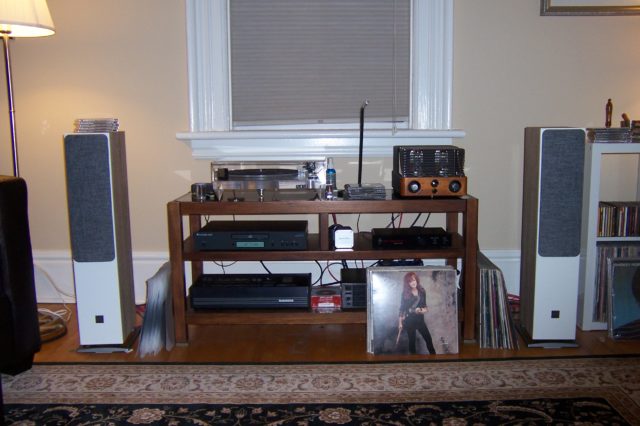
What About the Competition?
Some comparisons to other speakers may be useful. Recently I had a pair of Fyne 501s briefly in the house. The Scottish Fynes are descended from the Tannoy tradition and use coincident drivers. The Fyne F501s offer the listener the type of quality sound one might expect from very good headphones, but without the need to have ‘cans’ clamped on your head. But their contrast with the DALIs is quite marked. The Fynes definitely require you to sit in the sweet spot (which is quite restrictive) in order to maximize the stereo effect, and their performance off-axis is limited.
A couple of years ago I auditioned a pair of Monitor Audio Silver 200 speakers, which are a similar size and shape to these DALIs, and a bit more expensive. My recollection is that the MA speakers were more laid back than the DALIs, and that they were polite but not particularly exciting. Still, they are a very good speaker for the money, and just a bit smaller than the well regarded Silver 300. Both of the silver series MA floor-standers have a natural presentation, but it isn’t particularly gripping. These DALI speakers excite the senses and in contrast are FUN FUN FUN. Thus, the more forward and robust sound field of the DALI Oberons would certainly be my preference.
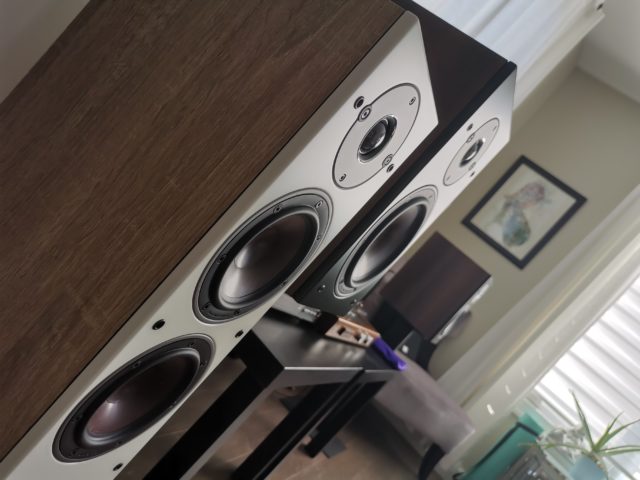 Finally, the reader will ask, what about comparing them to your reference J.M. Reynaud Bliss Jubilee speakers? This is a more formidable comparison and goes to the heart of differences between even very good speakers. As I have noted in reviews before, the JMRs are intimacy-seeking speakers. When playing an ensemble track, the JMRs will pull you in and almost hypnotize you into following one voice and examining it intimately. The DALI speakers focus more on the fun of ensemble playing and they accentuate the total picture.
Finally, the reader will ask, what about comparing them to your reference J.M. Reynaud Bliss Jubilee speakers? This is a more formidable comparison and goes to the heart of differences between even very good speakers. As I have noted in reviews before, the JMRs are intimacy-seeking speakers. When playing an ensemble track, the JMRs will pull you in and almost hypnotize you into following one voice and examining it intimately. The DALI speakers focus more on the fun of ensemble playing and they accentuate the total picture.
But that intimacy of the JMRs leads to emotional involvement and this is something that the JMRs do better than any other speaker I know. They supremely communicate musical emotion and will set you up for those ‘shiver’ moments we love. The DALI Oberons can induce the shivers too but not as frequently or as strongly. In contrast, the DALI speakers highlight the playful fun in making music and are always a joy to listen to.
But this last comparison must also be mindful of price. The JMRs with their approved Magic Stands cost well over three times the price of a pair of Oberon 5s.
In the end it all comes down to personal preference; intimacy versus fun. I want them both and this is why I am keeping the DALIs and adding them to my collection.
Summing Up
After four weeks of listening I am convinced that these speakers deserve special commendation. So I am designating the DALI Oberon 5 speakers a Wall of Sound Gold Star Winner for value and sound.
In summary, I just love them and I think you will too.
Thanks to Stereo Untypical for the opportunity to audition the DALI Oberon 5.
Dali Oberon 5: MSRP $1399 Canadian
Technical Specifications – Two-way bass reflex floorstanding speakers; frequency range of 39 Hz to 26 KHz; 6 ohm impedance and 88 db sensitivity; crossover frequency at 2400 Hz; 29 mm soft dome textile tweeter; two 5.25″ paper and wood fibre cone mid-woofers; amplifier power recommended from 30 to 150 watts. Additional info: https://www.dali-speakers.com/products/oberon/oberon-5/
Distributor (N.America): Lenbrook Industries
Web: https://www.dali-speakers.com/
Disclaimer: The owner/editor of Wall of Sound (Noam Bronstein) also owns Stereo Untypical, which is now a DALI retailer. This review was conducted independently of his input.

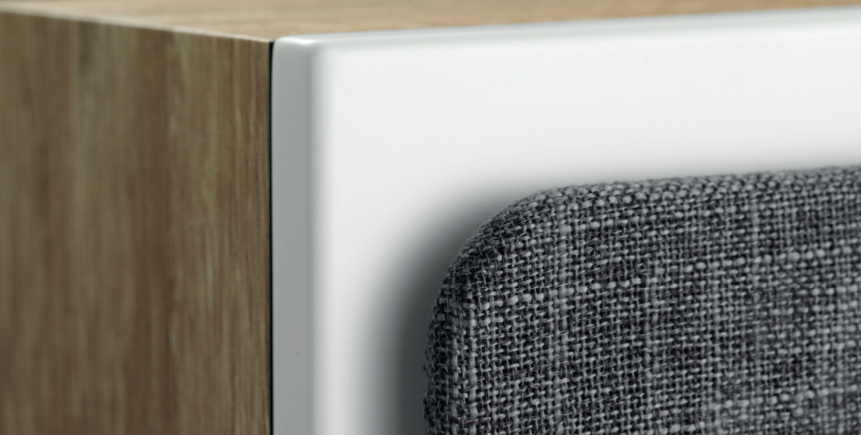
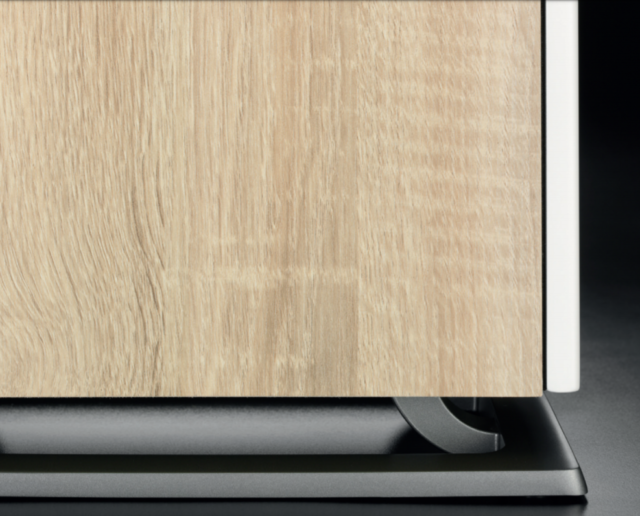
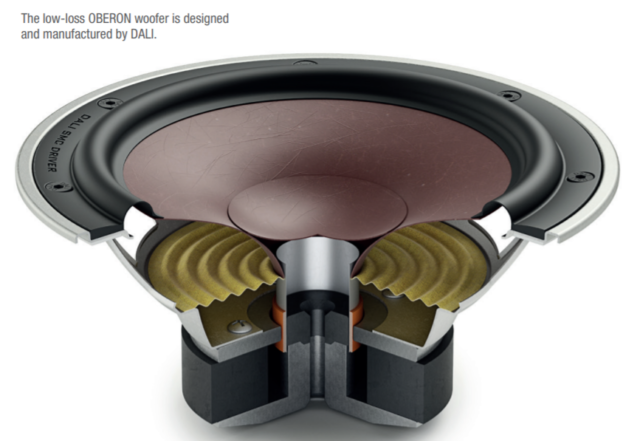
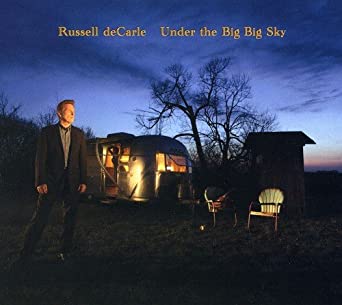
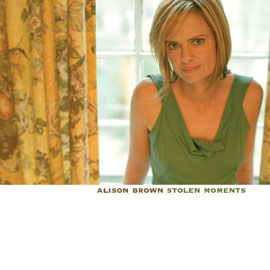

Thanks for the great review. The sense of fun you describe reminds me of my Rega RS5, also diminutive floorstanders with paper cones. Highly infectious and with remarkable mids/highs. These DALI sound like they might be better with lower frequencies. Definitely want to audition.
Will the HEED integrated amp (mentioned in the review) pair well with the Dali ?
Also, will about 8 inches from front wall work ?
Hi,
About the Heed. I have not heard the pairing but they should match well. The Oberons are very amp friendly and easy to drive. The Oberons have a rear port but are not very fussy about the distance they are placed from the front wall. I think a foot would be a good idea but you might try closer. At 12 to 15 inches the bass is very balanced. Good luck. Cheers David Neice
David, once again, great review! I have been auditioning the Dali Oberon 3’s and they are fantastic – especially for the price. Noam at Stereo Untypical graciously let me demo a pair but after reading your review and looking at my space, I have just ordered a new pair of Dali Oberon 5’s!
Thanks
Thank you for the insightful review. It’s appropriate that you should draw comparisons with your JMRs. I have a pair of Cantabiles i purchased around 1999, for about $2400. It’s remarkable to see and hear what we can get in the hifi world these days. I have been considering a speaker change as of late, and your impressions of this Dali spkr has me on the verge. Might you consider it a sideways move? They say change is good, but is it necessary? Thanks again,
Hi there! Would you think that the Oberon 7s would be worth it over the 5s, especially with a sub?
Hi Charlie,
My two cents, if you have a sub you intend to use, the Oberon 5’s should be plenty in all but the largest rooms. They don’t even need a sub for music, really. With the 7’s I couldn’t imagine using a sub – except possibly if you’re into movie LFE’s or gaming.
David may have additional thoughts. Thanks for your comment!
Noam
Hi, I have a narrow listening room of 8 feet wide and 13 feet long. Do you think these speakers would be suitable in a nearfield setup, 6 feet apart and myself 6-7 feet back? Thanks for the excellent review.
Helge,
Thanks for your comment. Personally I think it might work ok. Depending on the styles of music and volume levels. You also might find the Oberon 3 or even the Oberon 1 to be quite capable in a room that size. David may have some additional thoughts.
Best regards,
Noam
Hi,
Just catching up here.
Note to Charlie. I agree with Noam, that the Oberon 7s certainly won’t need any sub at all but the 5s could be integrated with a sub if the cross-over frequency is kept really low.
Note to Hedge: I think the 3s might be a better bet in your room situation but if the 5s are kept six feet apart they will still image correctly. I have them placed at seven feet apart with the listening chair seven feet feet from the fronts – almost near field.
Cheers,
David Neice
Hi David,
Just finished reading your review on the Oberon 5. I have the Oberon 7 with the Marantz pm7000n and I must say I’m quite happy with them even though I think a little more detail would be welcome.
Have you heard these 7’s with the Marantz?
Hello,
In the process of downsizing and looking to replace my vintage speakers. These Oberon 5 keep popping up as more than suitable for a small space with great imaging and separation. I have a pair of JBL L-36 and a pair of ADC 2 ways with an ADC sub. Great sounding speakers but all contribute to a bigger footprint. I would be running an older Marantz PM500. Wondering what your thoughts are on this. Thanks, enjoyed the review.
Hello,
You wrote: ‘These Oberon 5 keep popping up as more than suitable for a small space with great imaging and separation.’
That pretty well sums it up. The thing they do is provide the sonic field of a much larger speaker system, all the while being a small footprint speaker. I think you will like them. They are easy to drive and the Marantz will fill the bill, at least initially until you get the urge to upgrade. I would say definitely ‘try them’. Cheers, David Neice
What is it with reviewers and the word ‘fun’? A review elsewhere of Monitor 300 speakers is peppered with ‘fun’. If the reviewer is enthusiastic, then ‘fun’ is the operative word. I’m suspicious of fun, as it’s an all-embracing lazy superficially which, when applied to audio, is rather off-putting. And the ‘footprint’ buzzword is parroted by those whose idea of fun is to alert folk to specific footprints.
Having heard the Oberon 5’s many times, I will defend David’s use of the word “fun”. It just fits. Keep those fun comments coming!
Hi guys,
I have the Oberon 5’s currently running beautifully on a Rega Elex R. Previously I had them running with a Rogue Sphinx v3 also with great results. I had a buddy over and he thought I had a subwoofer hidden somewhere, but I didn’t. I really enjoy these more than any other speakers that I’ve owned. They sound much bigger than they are and they definitely add presence and sonically almost completely disappear! Enjoy the music and glory to Ukraine! 🇺🇦🇺🇸👊